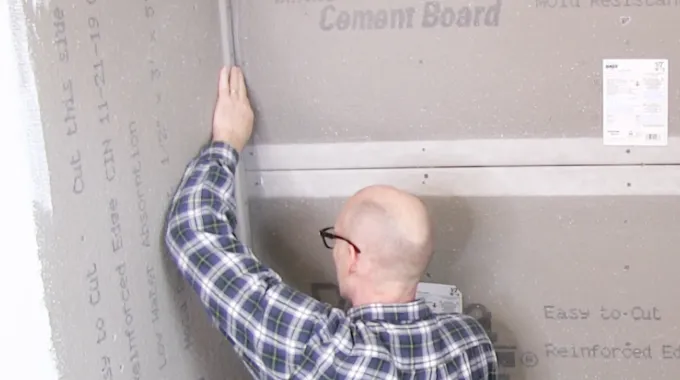Last Updated on September 13, 2023
When repairing drywall, you can use any type of tape, but for cement boards, it’s a different story. Knowing the right kind of tape is key to having an effective and long-lasting job that won’t need redoing down the line.
If you’re planning a project that requires cement board, leave standard paper or metal drywall tape behind and opt for fiberglass mesh or ultra-thin fiberglass, both of which boast stronger adhesion.
With the help of fiberglass mesh tapes, you’ll enjoy easy installation and fire- and water-resistant benefits. So why not check out this blog post, where we reveal everything you need to know about choosing the right type of drywall tape for your project?
What Tape Do You Use on the Cement Board?
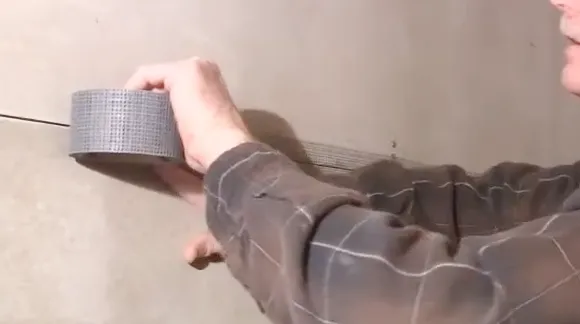
1. Fiberglass Mesh Drywall Tape:
Fiberglass mesh drywall tape is a better option for use on cement boards since it is made of a stronger material than paper drywall tape and is less prone to cracking or tearing when exposed to moisture and humidity.
The mesh-like structure of fiberglass mesh drywall tape gives it additional strength and flexibility when filling in gaps between cement board pieces. This type of drywall tape also provides superior adhesion and creates a more reliable seal against water intrusion or air leakage.
2. Ultra-thin Fiberglass Drywall Tape:
Ultra-thin fiberglass drywall tape is an even better choice for use on cement boards due to its incredibly thin profile, allowing it to easily fit into tight spaces that are too narrow for traditional metal or paper drywall tapes.
This tape is also quite strong despite its thin size, making it ideal for creating long-lasting seals around corners and other hard-to-reach areas on cement board surfaces.
What Tape Do You Not Use on the Cement Board?
1. Paper Drywall Tape:
Paper drywall tape should not be used on cement boards because it is not strong enough to withstand the rigors of providing a seamless, firm seal between the drywall and the cement board.
Additionally, the paper tape may become brittle over time in an alkaline environment when in contact with moisture and humidity, which can cause it to crack or tear away from the surface of the cement board.
2. Metal Drywall Tape:
The use of metal drywall tapes is not recommended on cement boards since they are too rigid and inflexible to fill in gaps and irregularities between cement board pieces.
Furthermore, metal tapes don’t provide good adhesion against cement boards due to their tendency to corrode when exposed to moisture over time which can lead to rusting and deterioration of their material quality.
How Do You Seal Seams in Cement Boards with Drywall Tape?
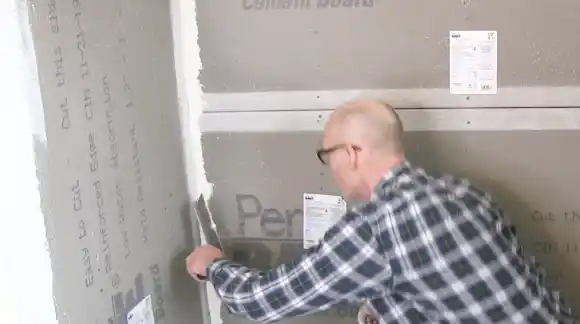
Step 1. Preparing the Tools and Materials:
Gather the necessary tools and materials required to seal seams in cement boards. This preparation includes a roll of fiberglass drywall tape, joint compound, a sponge or rag for cleaning up excess mud, and a utility knife or saw for cutting the drywall.
It is also helpful to have some sandpaper and a paintbrush on hand in case there are any high spots that need to be sanded down at the end of sealing the seams.
- Fiberglass Mesh Tape
- Joint Compound
- Sponge or Rag
- Utility Knife or Saw
- Sandpaper
- Paintbrush
You Might Also Like: How do you re-tape over ripple drywall tape?
Step 2. Cutting and Securing the Drywall:
Before sealing seams in cement boards, cut the drywall so it matches up with the thickness of the cement board. Ensure that there is at least a one-inch overlap of cement board at both edges of walls and ceilings before securing it into place.
Once secured, any excess material should be trimmed away with a utility knife or saw if needed.
Step 3. Taping off the Seam with Fiberglass Drywall Tape:
After all, edges are properly secured, fiberglass drywall tape should be applied over all seams between the cement board and drywall pieces.
To do this, start in one corner and unroll several feet of tape along one side until you reach the opposite corner. Tape the remaining sides until they are all completed. As you go along, ensure that you press firmly enough on each piece so that it adheres properly.
Don’t press too hard, as this can cause tears in either material or damage your wall edges beyond repair.
Step 4. Applying a Minimal Amount of Mud Over The Tape:

When applying drywall mud over the taped seams, make sure to use small amounts so as not to overfill them. If it overlaps, it can cause cracking down the line or create too much bulkiness around corners, which can interfere with painting later on down the road.
For best results, use two thin coats rather than one thick coat, which will help ensure complete coverage across all surfaces without creating unnecessary bulkiness.
Bulky materials could lead to cracking issues later on down the line once everything dries out completely from its current wet state.
Step 5. Allow to Dry Mud and Clean Up Any Excess Dried Mud:
Once all mud has been applied over taped seams between cement board pieces and allowed time to dry completely (usually 24 hours). Use a wet sponge or cloth rag (or even your hands) to remove any excess dried mud left behind by gently wiping it away from walls/ceilings/corners etc.
Then use sandpaper lightly along any high spots that may have shown up during the drying process, which can result in bumps/bulges once painted afterward if not taken care of prior painting stage.
When finished cleaning up all excess dried mud, go ahead and paint walls/ceilings/corners, etc, for optimal results if desired.
Benefits of Using Fiberglass Drywall Tape on Cement Board
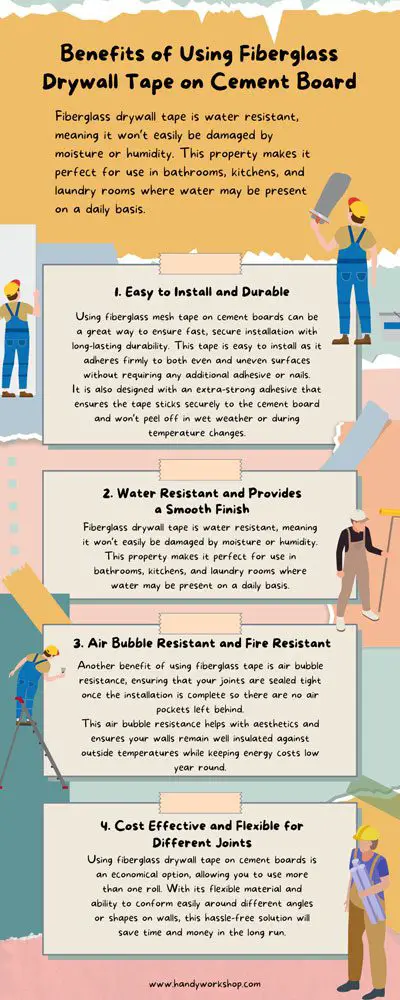
1. Easy to Install and Durable
Using fiberglass mesh tape on cement boards can be a great way to ensure fast, secure installation with long-lasting durability. This tape is easy to install as it adheres firmly to both even and uneven surfaces without requiring any additional adhesive or nails.
It is also designed with an extra-strong adhesive that ensures the tape sticks securely to the cement board and won’t peel off in wet weather or during temperature changes.
Fiberglass tape also has superior tensile strength that further improves its sturdiness, making it ideal for high-traffic areas such as stairwells and entryways with more potential for wear and tear.
These properties make the tape extremely durable, lasting longer than competing products without requiring frequent replacement over time.
Recommended Article To Read: Would it be possible to stack stones on plywood?
2. Water Resistant and Provides a Smooth Finish
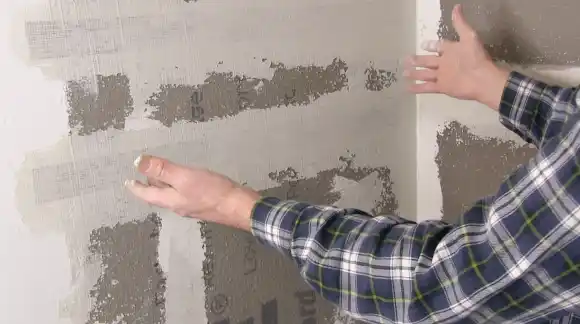
Fiberglass drywall tape is water resistant, meaning it won’t easily be damaged by moisture or humidity. This property makes it perfect for use in bathrooms, kitchens, and laundry rooms where water may be present on a daily basis.
Its water resistance also helps protect walls from potential mold growth when used outdoors or in moist climates. On top of this, fiberglass drywall tape provides a smooth finish upon application, so you don’t have to worry about bumps or imperfections ruining the look of your wall surfaces.
3. Air Bubble Resistant and Fire Resistant
Another benefit of using fiberglass tape is air bubble resistance, ensuring that your joints are sealed tight once the installation is complete so there are no air pockets left behind.
This air bubble resistance helps with aesthetics and ensures your walls remain well insulated against outside temperatures while keeping energy costs low year round.
Homeowners can rest easy knowing that fiberglass mesh tape is an effective safety barrier against extreme heat sources like fireplaces or furnaces. Homeowners can feel secure knowing that this material won’t catch on fire easily.
4. Cost Effective and Flexible for Different Joints
Using fiberglass drywall tape on cement boards is an economical option, allowing you to use more than one roll. With its flexible material and ability to conform easily around different angles or shapes on walls, this hassle-free solution will save time and money in the long run.
This type of tape firmly attaches itself around corners without needing additional nails or screws, meaning it takes less labor costs in installation, leading to long-term savings.
What Do You Use to Mud Joints of Cement Board?
When mudding joints in cement board, it’s important to use thinset mortar or cement specifically designed for this purpose. Applying thinset mortar allows for a smooth and even finish along the seams of the boards while providing adequate adhesion and support for tiles during installation.
Clean off any thin-set mortar left on cement board surfaces after application. This not only helps to achieve a more even surface but also ensures that the mortar doesn’t dry out too quickly. To remove excess thin-set mortar, you can use a trowel or a putty knife to scrape away any excess material.
Adding fiberglass mesh drywall tape to the mortar can add strength and stability to large-scale projects where extra protection is needed.
What Kind of Tape Do You Use for the Durock Cement Board?
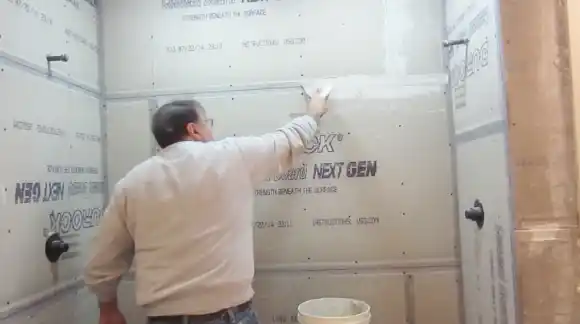
For Durock cement boards, it is recommended that fiberglass mesh drywall tape or ultra-thin fiberglass drywall tape is used when taping up seams between sections of the board. This type of tape provides superior strength and flexibility compared to traditional paper drywall tapes or metal meshes.
What Can You Use to Fill Gaps in the Cement Board?
The most common method for filling gaps in cement boards is by using thinset mortar or cement specially formulated for this purpose. Thinset is easy to apply using either a notched trowel or grout bag, depending on the size of the gap being filled.
Can You Use Drywall Tape on Hardie Board?
There’s no point in using paper drywall tape or metal drywall tape with Hardie Board. These materials don’t work with it because they don’t hold up against high-temperature changes that come with Hardie Board’s chemical composition, and it deteriorates over time as a result.
If you plan to join different sections together, only ultra-thin fiberglass drywall tapes or self-adhesive tapes made specifically for Hardie Boards should be used.
These mesh tapes have been extensively tested under extreme conditions and have proven to provide superior performance compared to traditional paper-based options available on the market today.
What Do You Use to Seal Cement Board Before Tiling?
The best way to seal cement board before tiling is to use a waterproofing membrane such as RedGard or Hydro Ban. These products are applied in two thin coats, usually with a paint roller.
Maximize Protection: Utilize Fiberglass Mesh Drywall Tape on Cement Boards
Using fiberglass drywall tape on cement boards is an effective way to create an airtight seal that is resistant to water damage and fire hazards. The easy installation process makes this type of product an ideal solution for taping drywall with cement boards.
With its flexibility, cost-effectiveness, and durability, fiberglass mesh drywall tapes are the perfect choice for covering joints and sealing seams in cement boards. Choose the appropriate drywall tape to avoid air bubbles and other problems.
